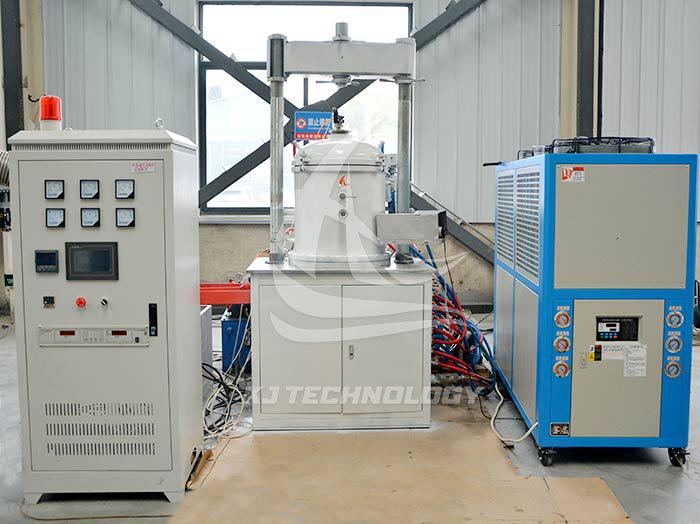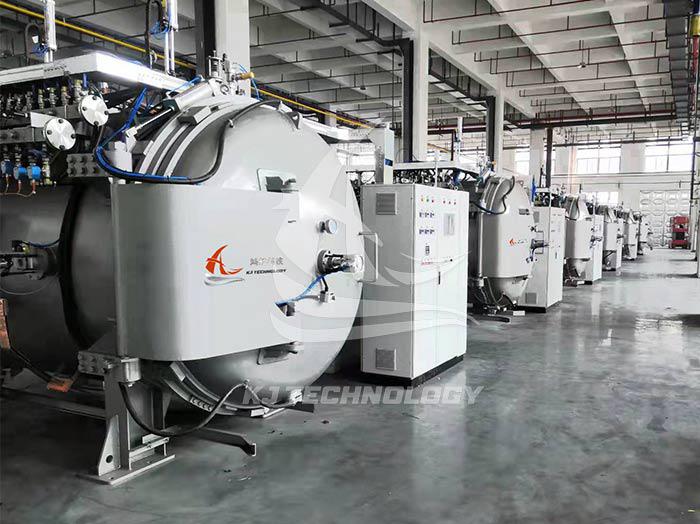Selection of High Temperature Vacuum Brazing Furnace
 03-24-2025 Author: KJ technology
03-24-2025 Author: KJ technology
The selection of high-temperature vacuum brazing furnace is a comprehensive process that requires consideration of multiple key factors to ensure that the selected equipment can meet specific process requirements. Here are some key steps and considerations:
1. Clarify process requirements
Material type: Determine the type of material that needs to be brazed, such as aluminum, titanium alloy, stainless steel, high-temperature alloy, etc. The requirements for brazing temperature, vacuum degree, and brazing atmosphere may vary among different materials.
Workpiece size and shape: Consider the size, shape, and furnace loading method of the workpiece to select the appropriate furnace size and loading mechanism.
Process requirements: Clearly define the process requirements for brazing, such as temperature uniformity, heating rate, cooling rate, etc.
2. Key performance indicators
Maximum temperature: Select a vacuum brazing furnace with a sufficiently high maximum temperature based on the melting point of the brazing material. For example, for brazing high-temperature alloys, it may be necessary to select equipment with a maximum temperature of 1600 ℃ or higher.
Temperature uniformity: Temperature uniformity is crucial for the quality of brazing. Choose equipment with high temperature control accuracy and good temperature uniformity, usually with temperature fluctuations controlled within ± 3 ℃.
Vacuum degree: High vacuum degree can effectively prevent material oxidation during heating and improve brazing quality. Choose equipment with medium to high vacuum levels, with a maximum vacuum level of 10−4Pa or higher.
Heating and cooling rates: Heating rate affects production efficiency, while cooling rate affects the microstructure and properties of brazed joints. Choose equipment with adjustable heating and cooling rates to meet different process requirements.
Temperature control accuracy: Temperature control accuracy directly affects the accuracy of brazing temperature control. Choosing equipment with high temperature control accuracy should usually reach ± 1 ℃ or higher.
3. Equipment structure and configuration
Furnace structure: Choose a suitable furnace structure based on the loading method and workpiece shape, such as a well furnace, vertical furnace, or horizontal furnace. At the same time, consider the sealing and insulation performance of the furnace body.
Heating element: Select appropriate heating element materials based on the requirements of maximum temperature and heating uniformity, such as molybdenum wire, graphite tube, or pigeon wire.
Vacuum system: The vacuum system is the key to achieving high vacuum levels. Choose a two-stage or three-stage pumping system consisting of mechanical pumps, Roots pumps, and diffusion pumps to achieve the desired vacuum level.
Cooling system: The cooling system is crucial for the performance and lifespan of the equipment. Choose water cooling or air cooling method to ensure the stability of the equipment during long-term operation.
Control system: Advanced control systems can improve the automation level and operational convenience of equipment. Choose equipment with programmable logic controllers (PLCs) or computer control systems to achieve precise temperature control and process monitoring.
4. After sales service and support
Technical support: Choose suppliers who can provide timely technical support and solutions to ensure the smooth operation of the equipment during use.
Maintenance service: Consider the supplier's maintenance service capabilities and response time, so that timely repairs can be made in case of equipment failure.
Spare parts supply: Understand the supplier's spare parts supply situation to ensure timely access to the required spare parts when needed.
5. Case reference
Taking a certain model of high-temperature vacuum brazing furnace as an example, its main technical parameters are as follows:
Maximum temperature: 1600 ℃
Working temperature: 1500 ℃
Temperature control accuracy: ± 1 ℃
High temperature uniformity: ± 3 ℃ (900 ℃, measured at 9 points in an empty furnace)
Ultimate vacuum degree: 8.0 × 10−4Pa
Evacuation rate: ≤ 30 minutes (timed to 5 × 10 when the high valve is open)−3Pa)
Time required for furnace temperature to rise from room temperature to 1500 ℃: less than 90 minutes
Time required for furnace temperature to drop from working temperature to 200 ℃: less than 30 minutes
This device is suitable for vacuum brazing of materials such as aluminum, copper, nickel, gold, stainless steel, composite materials, and high-temperature alloys, and has the characteristics of high efficiency, energy saving, stability, and reliability.
6. Summary
In the selection process, factors such as process requirements, key performance indicators, equipment structure and configuration, after-sales service and support should be comprehensively considered. By comparing different brands and models of equipment, choose the high-temperature vacuum brazing furnace with the highest cost-effectiveness and most suitable for your own needs. At the same time, it is recommended to have sufficient communication with suppliers to understand the detailed performance and configuration of the equipment, in order to make more informed decisions.








